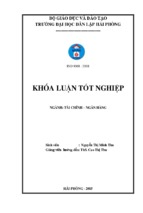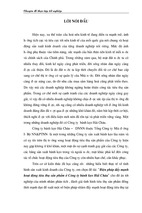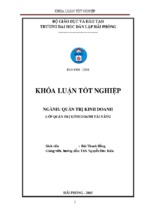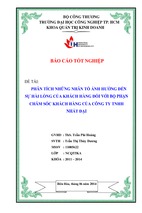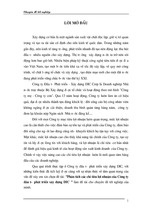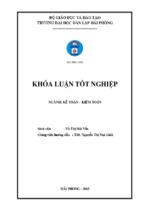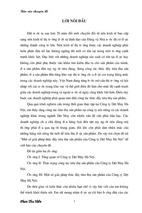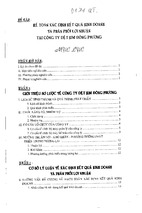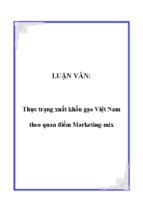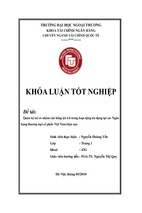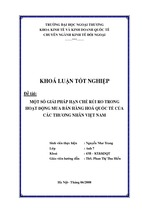SoPuEblCe IIsAsuLe
Champions of Profitable Growth…page 59
D
www.hbr.org
Top-Line
Growth
[The Leader]
66
[The Deal]
Amgen CEO
Kevin Sharer:
A Time for Growth
When to Ally and
When to Acquire
Jeffrey H. Dyer, Prashant
Kale, and Harbir Singh
Paul Hemp
[The Idea]
[The Customer] 116
76
Getting the Most
out of All Your
Customers
Funding Growth in
an Age of Austerity
Gary Hamel
and Gary Getz
[The Strategy]
Jacquelyn S. Thomas,
Werner Reinartz,
and V. Kumar
86
Darwin and the
Demon: Innovating
Within Established
Enterprises
[The Dilemma] 124
How CEOs Manage
Growth Agendas
Kenneth W. Freeman,
George Nolen,
John Tyson,
Kenneth D. Lewis,
and Robert Greifeld,
with an introduction
by Ranjay Gulati
Geoffrey A. Moore
[The Market]
108
94
Selling to the
Moneyed Masses
Paul F. Nunes,
Brian A. Johnson, and
R. Timothy S. Breene
July–August 2004
The advantage of working together is amazingly clear.
Over the past 40 years, we’ve built partnerships with automakers, universities and government agencies, which have
helped reduce new car emissions by 96%. Partnerships like these are helping us develop cleaner, more efficient energy
for everyone. Because together, anything is possible.
Official Partner of the
2004 U.S. Olympic Team
Turning partnership into energy.™
©2004 ChevronTexaco Corporation. ChevronTexaco is a trademark of ChevronTexaco Corporation. 36 USC 220506
Andre Agassi’s coach
Introducing the Collaborative Business Experience
www.us.capgemini.com
“Helping him get results, that’s what I’m all about”
HBR
94
To p - L i n e G r o w t h
Features
July–August 2004
86
66
THE LEADER
A Time for Growth: An Interview
with Amgen CEO Kevin Sharer
Paul Hemp
Leaders face big challenges when their companies are on a
roll. One of the biggest, says the CEO of the world’s largest
biotech company, is learning to juggle them all at once.
76
THE IDEA
Funding Growth in an Age of Austerity
Gary Hamel and Gary Getz
Solid, enduring corporate growth springs from innovations,
not acquisitions. But that doesn’t mean R&D spending
has to go through the roof. Here are five proven ways to
innovate on the cheap.
86
T H E S T R AT E G Y
108
Darwin and the Demon:
Innovating Within Established Enterprises
94
76
THE DEAL
When to Ally and When to Acquire
Geoffrey A. Moore
Jeffrey H. Dyer, Prashant Kale, and Harbir Singh
Innovate or become extinct. But choose the form of
innovation carefully – different phases of a market’s
life favor different types.
Avoid dismal results from acquisitions and alliances
by systematically comparing the two strategies before
you make a deal. Here’s a framework for determining
the best option for achieving your growth objectives.
THE MARKET
116
Selling to the Moneyed Masses
THE CUSTOMER
Paul F. Nunes, Brian A. Johnson,
and R. Timothy S. Breene
Getting the Most out of All Your Customers
The top 20% of earners in the United States
account for 49% of total income, yet they
make up only 37% of the country’s
total spending. That spells opportunity. Marketers should
be looking for ways to reach
the new affluent masses.
Loyal customers don’t produce stable, healthy growth.
Profitable ones do. A new analytical tool can tell you how
many marketing dollars you really need to spend (and
just what to spend them on) to find those customers – all
of them.
Jacquelyn S. Thomas, Werner Reinartz, and V. Kumar
124
THE DILEMMA
Kenneth W. Freeman, George Nolen, John Tyson,
Kenneth D. Lewis, and Robert Greifeld, with an
introduction by Ranjay Gulati
Too many companies are caught in a deadly game of
commoditization that gets in the way of growing the top
line. Five executives tell us about growth strategies that
have worked for them.
116
6
continued on page 8
harvard business review
COVER ART: CURTIS PARKER
How CEOs Manage Growth Agendas
“We’ve cut our build-to-order lead times by over
50 percent with PeopleSoft Manufacturing.”
— John Wigginton, Vice President of IT, Cybex
Great companies around the world rely on PeopleSoft enterprise application software.
Growing companies like Cybex outmuscle the competition with PeopleSoft Manufacturing solutions.
Now a demand-driven enterprise, Cybex has dramatically collapsed order lead time, while lowering
inventories and ensuring on-time delivery. To find out more, visit www.peoplesoft.com/goto/demanddriven
or call 1888 773 8277.
Manufacturing
HBR
D e pa r t m e n t s
106
July–August 2004
S T R AT E G I C H U M O R
BEST OF HBR
10
138 Marketing Myopia
FROM THE EDITOR
Theodore Levitt
Growing at a Smart Pace
Recently, 250 top executives from one
of the bluest of blue-chip companies attended a weeklong executive-education
program at Harvard Business School.
What was the one topic they studied?
Top-line growth. For those who did not
attend, read on.
The secret to ensuring continued growth
lies in a lesson too many industries have
learned the hard way: Instead of thinking
about their products, companies must
think about their customers.
10
150 The Middle Manager
as Innovator
Rosabeth Moss Kanter
FORETHOUGHT
18 What Every CEO Should Know
About Creating New Businesses
21 Turn Your Budgeting Process
Upside Down
24 Which Way Should You Grow?
27 Stop Kissing Frogs
29 Innovation as a Last Resort
35
Some of the greatest achievements come
not from the top but from the middle.
With access to the right resources, enterprising middle managers can uncover
opportunities and make change happen.
18
162 Staple Yourself to an Order
Benson P. Shapiro, V. Kasturi Rangan,
and John J. Sviokla
Many organizations suffer from gaps
in their order management cycle that
can cause internal strife and damage
customer relationships. By “stapling
themselves to an order,” managers can
isolate these breakdowns, helping their
companies reconnect with customers
and improve financial performance.
BOOKS IN REVIEW
The Growth Boosters
Pankaj Ghemawat
The economy might have been stalled,
but there’s been no shortage of books
on growth. Which ones are worth
your time? One expert offers a critique
of three recent books and sounds a
cautionary note against overzealous
growth targets.
45
35
172 Value Innovation: The Strategic
Logic of High Growth
W. Chan Kim and Renée Mauborgne
The difference between high-growth
companies and their less successful
competitors is a matter of fundamental
assumptions about strategy.
HBR CASE STUDY
Cross Selling or Cross Purposes?
Ford Harding
Cross a software maker with a consulting firm, and the result is a clash of
cultures, a dysfunctional compensation
system for sales, and customers who
say they’re being driven nuts.
59
45
181
LETTERS TO THE EDITOR
Playing hardball can make a company
a champ – or maybe just a bully.
BIG PICTURE
184
EXECUTIVE SUMMARIES
192
PA N E L D I S C U S S I O N
Champions of Profitable Growth
G. Bennett Stewart III
Growth is good, as far as it goes. But
not every company that succeeds in
driving top-line growth can convert
it into shareholder value. Here are
the ones that have.
8
Soup to Nuts
Don Moyer
138
If your brand is a confusing, unappetizing
stew, it may be time to get back to basic
ingredients.
harvard business review
SUPPLY CHAINS. SYNCHRONIZED.
UPS can help you shorten your
supply chain. For a technical
explanation, see figures A. and B.
SM
At UPS Supply Chain Solutions ,
we have the full range of expertise
to help you turn your supply chain
into a strategic asset.
Supply Chain Design and
Planning
We’ll help you take a critical
look at your current supply chain.
Then work with you to design a
more effective model. One that
makes better use of your
resources, and ultimately gets
your inventory to market faster.
Logistics and Distribution
Services
We can help improve your
global distribution process by
finding better ways to handle
materials sourcing, order fulfillment, and even final delivery
compliance. We’ll also make
sure your reverse logistics are
working just as efficiently.
Transportation and Freight
Whether you’re shipping ocean,
air, road or rail, our network
can handle it all. We combine
freight services with customs
brokerage and warehousing.
And we have the technology to
give you visibility of your goods
all along the way.
International Trade
Management
UPS has been helping
customers trade internationally
for over 70 years, with customs
brokerage services that span
the world. All of which means
faster customs clearance, fewer
cargo delays, and reduced noncompliance fees.
© 2004 United Parcel Service of America, Inc. UPS, the UPS brandmark, and the color brown are trademarks of United Parcel Service of America, Inc. All rights reserved.
UPS-SCS.com 1-866-822-5336
FROM THE EDITOR
Growing
at a Smar t Pace
ou are holding a special double
issue of Harvard Business Review.
It is a collection of the best thinking
we could find on a topic that is paramount in executive offices: growing
the top line. How important is it?
A few months ago, the Harvard Business School campus was flooded with
250 top executives from one of the
bluest of blue-chip companies. The
entire senior team came for a week,
including the CEO for most of the
time. They studied one subject: topline growth.
Consider this issue of HBR the next best thing: a comprehensive look at the sources of sales growth; the strategies that produce it; the means of ensuring that it is profitable; and – crucially – the role of leaders in promoting and
sustaining it. Senior editors Julia Kirby, Anand Raman,
and Bronwyn Fryer planned this issue to be thorough,
first – to cover the topics you would expect to see, from
innovation to marketing to mergers. But they also wanted
it to surprise – to shine new light on familiar subjects and
to discover original ideas in unexpected places.
I hope you’ll agree that they succeeded brilliantly. It
seems almost arbitrary to pick just a few items from this
jewelry box, but here are some things I learned (and a couple that I relearned) as the articles came across my desk:
• I knew that innovation is more than new product development. There’s innovation in marketing, in business models, in processes, and more. But till I read Geoffrey Moore’s
“Darwin and the Demon,” I hadn’t realized that where
a product is in its life cycle determines which kind of innovation will do the most good. We’ve long wanted to publish
Geoff – the author of Crossing the Chasm, among other
books – and it is a pleasure to welcome him.
• I knew most companies make a hash of both acquisitions and alliances. But I hadn’t figured out that often the
problem is that companies take over firms they should
have collaborated with, and vice versa. Brigham Young’s
Jeff Dyer, Michigan’s Prashant Kale, and Wharton’s Harbir
Singh (the latter two also new to HBR) show how companies can avoid a lot of grief by understanding how to
choose between allying and acquiring.
10
• I’d read much about income distribution. But in “Selling to the Moneyed Masses,” Paul Nunes and Tim
Breene, both from Accenture, and researcher Brian Johnson surprised me
with data that ought to make every
company reexamine its customers:
While your marketing people targeted
ever-narrower customer segments, a
new mass market was forming – a forest of prosperous customers you may
have missed from looking too closely
at the trees.
• And I knew that CEOs have a special perspective because of their responsibility for allocating capital within the companies they lead. But this issue
includes the voices of six chief executives – an interview
with Amgen’s Kevin Sharer, and thoughtful essays by five
others, with a commentary by the Kellogg School’s Ranjay
Gulati. The top line looks different from the top. You can’t
explain that difference – but you can experience it, and you
do in these articles.
A final note: One of HBR’s greatest strengths – which our
authors know but which is almost invisible to readers – is
our cadre of manuscript editors. Most magazines have staffs
of copy editors, who correct grammar and spelling, fix inconsistencies, and apply a final polish to prose and style.
HBR’s manuscript editors – Christina Bortz, Lisa Burrell,
Roberta Fusaro, Margaret Hanshaw, Andy O’Connell, and
Andrea Ovans – do that and more. They become partners
with the authors and senior editors. Sometimes they find
subtle errors of logic or design; often they take charge of
making charts and exhibits clear and useful; always, and
almost magically, they turn knotty passages into straightforward, even elegant prose. And they do it on deadline.
This double issue, with 14 full-length articles, put huge demands on the manuscript editors, who met the challenge
heroically. You wouldn’t be reading it without them.
ROBERT MEGANCK
Y
Thomas A. Stewart
harvard business review
for the first time ever,
fly non - stop from new york to singapore.
Now the world is an even smaller place. After introducing the first
non-stop flight between Los Angeles and Singapore in February,
Singapore Airlines now offers daily non-stop service between New York
( Newark ) and Singapore. Enjoy more comfort and space on our new
Airbus 340 – 500 while reducing travel time by up to four hours.
Experience a more luxurious Raffles Class or our new Executive
Economy Class, both specially designed with the executive traveler in
mind. And of course, the inflight service even other airlines talk about.
www.nonstop2singapore.com
PROCESS HUNDREDS OF
PAYMENTS IN MINUTES...
ExactPay Global Clearing.
™
When you have suppliers to pay all over the world,
Global Clearing can help you:
Upload large volumes of international payments by simply
inputting the beneficiary code and the amount to be paid.
●
Upload batch payment instructions directly from your
back-office systems.
●
Connect your legacy systems with Global Clearing using a
universally accepted file format.
●
Authorize and authenticate bulk payments in compliance
with your corporate signature management policies.
●
Generate payment instructions in one city, review them in
another, and approve them in a third.
●
Assign employees different account access to prepare
payments in bulk, view accounts and verify payment information
on authorized transactions.
●
●
deputy editor
Karen Dillon
executive editor
Sarah Cliffe
art director
Karen Player
senior editors
Leigh Buchanan
David Champion
Diane L. Coutu
Bronwyn Fryer
Ben Gerson
Paul Hemp
Julia Kirby
Gardiner Morse
Ellen Peebles
Anand P. Raman
SAVE THOUSANDS
OF DOLLARS IN
TRANSACTION FEES!
●
editor
Thomas A. Stewart
Make global payments in any currency, anytime, and manage
accounts online 24/7.
Each payment instruction is uniquely authenticated and a
sophisticated transaction engine delivers error-free data. Fully
redundant operations centers facilitate the routing of payments,
ensuring information is never lost. Real-time posting gives you
an accurate, instant global status report with just a few clicks.
To make your global payment system world-class, see our
free online demo at www.globalclearingdemo.com/hbr or
call 1-888- 457-1231, ext. 2140 today.
ExactPay is a registered trademark of ExactPay N.V.
ExactPay Global Clearing is a key feature of the First Curaçao International Bank, N.V. online banking service.
associate
editor
Eileen Roche
consulting
editor
Louise O’Brien
manuscript
editors
Christina Bortz
Lisa Burrell
Roberta A. Fusaro
Margaret K. Hanshaw
Andrew O’Connell
Andrea Ovans
editor for
business
development
John T. Landry
executive editor
and director
of derivative
products
Jane Heifetz
senior
production
manager
Dana Lissy
associate
production
manager
Christine Wilder
senior designer
Jill Manca
production
coordinator
Josette AkreshGonzales
design/production
coordinator
Heather Barrett
communications
manager
Cathy Olofson
editorial
coordinators
Kassandra Duane
Andrew Gray
contributing
staff
Amy L. Halliday
Amy N. Monaghan
Annie Noonan
Suki Sporer
editor-at-large,
harvard business school publishing
Walter Kiechel
a note to readers
The views expressed in articles are
the authors’ and not necessarily those of
Harvard Business Review, Harvard Business
School, or Harvard University. Authors may
have consulting or other business relationships
with the companies they discuss.
submissions
We encourage prospective authors
to follow HBR’s “Guidelines for Authors”
before submitting manuscripts. To obtain a
copy, please go to our Web site at www.hbr.org;
write to The Editor, Harvard Business Review,
60 Harvard Way, Boston, MA 02163; or send
e-mail to
[email protected].
Unsolicited manuscripts will be returned
only if accompanied by a self-addressed
stamped envelope.
editorial offices
60 Harvard Way, Boston, MA 02163
617-783-7410; fax: 617-783-7493
www.harvardbusinessonline.org
Volume 82, Number 7/8
July–August 2004
Printed in the U.S.A.
ON
INCR EAS
ING
RO
I
M
M FREEING UP
PE
OP
LE
TO
F
US
OC
EA
NS
CUT
F RO
S
ME
O
C
TI N G C O S T S W
H
IL
E
B
O
OS
TI
NG
PROD
UC TI V I T
Y W
HI
C
H
HR&Benefits Outsourcing | Payroll | Retirement&Financial Management | Health Care | Talent&Organizational Change
©2004 Hewitt Associates LLC
www.hewitt.com/results
MITSloan Executive Education
publisher
Cathryn Cronin Cranston
Innovation is dependent on effective execution as
well as creative ideas. MIT Sloan Executive Education
provides the tools and frameworks to transform today’s
good ideas into tomorrow’s successful products and
services. With our world-renowned faculty and legacy
of leading-edge research, we offer programs that turn
high-potential managers into innovative leaders.
innovation
@work
The MIT Sloan Fellows Program in
Innovation and Global Leadership
A selective and intensive master’s
program for mid-career executives.
Now offered in full-time and
flex-time options.
Upcoming non-degree programs include:
Understanding & Solving Complex Business Problems
September 9 –10 • December 6–7
Driving Strategic Innovation
September 19–24
Building, Leading and Sustaining the
Innovative Organization
September 20–21 • November 30 –December 1
Developing & Managing a Successful Technology
and Product Strategy
September 22–23
For more information on these and other programs,
including custom courses, contact us at:
http://mitsloan.mit.edu/hbr
[email protected]
617-253-7166
circulation
fulfillment
manager
Heather McCormick
business
director
Edward D. Crowley
direct marketing
manager
Bruce W. Rhodes
manager,
marketing and
operations
Marisa Maurer
senior business
analyst
Adrienne M. Spelker
advertising
production
manager
Catharine-Mary
Donovan
assistant
subscriber
services manager
Elizabeth Sottile
assistant
advertising
manager
Ashley C. Hartmann
worldwide advertising offices
advertising director – worldwide
Trish Henry
212-872-9283
New York Maria A. Beacom
Michael J. Carroll
James H. Patten
509 Madison Ave.
15th Floor
New York, NY 10022
212-872-9280;
fax: 212-838-9659
Atlanta
Boston
Chicago
Dallas
Detroit
Los Angeles
San Francisco
Brazil
France
Latin America
Mexico
Sweden
United Kingdom
404-256-3800
978-287-5400
312-575-1100
214-521-6116
248-524-9000
310-207-4399
415-986-7762
5511-3285-2754
33-01-4643-0066
562-738-4033
5255-5081-6838
48-8-541-318-37
44-20-7586-2224
For all other inquiries,
please call 212-872-9280.
For advertising contact information,
please visit our Web site at
www.hbradsales.com.
subscription service information
u.s. and canada
800-274-3214; fax: 902-563-4807
Rates per year: U.S., $118; Canada, u.s.$128
international
44-1858-438868; fax: 44-1858-468969
Rates per year: u.s.$165; Mexico, u.s.$128
subscribe online
www.hbr.org
reproduction
Copyright © 2004 Harvard Business School
Publishing Corporation. All rights reserved.
No part of this publication may be reproduced
or transmitted in any form or by any means,
electronic or mechanical, including photocopy,
recording, or any information storage and
retrieval system, without written permission.
Oracle Applications
Runs
The Oracle E-Business Suite
The Best Companies
Run Oracle Applications
oracle.com/best
or call 1.800.968.4664
Copyright © 2004, Oracle Corporation. All rights reserved. Oracle is a registered trademark of Oracle Corporation and/or its affiliates.
7-ELEVEN® and the 7-ELEVEN Design are registered trademarks of 7-Eleven, Inc.
F o r e t h o u g h t
thinking about…
What Every CEO Should Know
About Creating New Businesses
Decades of research agrees – growth ultimately means starting new businesses.
That’s not easy, more for cultural than economic reasons.
by David A. Garvin
“Some problems,” wrote Laurence J. Peter, the
business humorist, “are so complex that you
have to be highly intelligent and well informed
just to be undecided about them.” Top-line
growth is one of those, especially when it comes
to creating new businesses within large, complex companies. The challenges are vast, and it’s
difficult to know how, or even whether, to move
forward. Most CEOs would benefit from having
a few rules of the road.
Fortunately, scholars have studied the problem for decades. And whether they’ve called it
“new business creation,”“corporate venturing,”
“corporate entrepreneurship,” “corporate innovation,” or “intrapreneuring,” their observations
have been remarkably similar. Yet these findings
have seldom been summarized or presented in
an easily accessible form. Here, then, is a primer
on the topic–the ten things every corporate venturer should know.
1 | Ultimately, growth means starting new
businesses. Most firms have no alternative. Sectors decline, as they did for Pullman’s railroad
cars and Singer’s sewing machines. Technology
renders products and services obsolete – the
fate Polaroid suffered, as digital cameras decimated its instant photography franchise. Markets saturate, as Home Depot is now finding,
after establishing more than a thousand stores
nationwide.
may be necessary for long-term growth, but successes are hard to pull off. The numbers are
downright depressing. In the 1970s and 1980s,
60% of small-business start-ups failed in their
first six years. Large companies did only a bit
better. A study of sizable corporations during
the same period, which included such household names as DuPont, Exxon, IBM, Procter &
Gamble, Sara Lee, 3M, and Xerox, found that
they divested or closed 44% of their internally
generated start-ups and 50% of their joint ventures in the first six years.
18
harvard business review
PATRICK BLACKWELL/WORKBOOKSTOCK
2 | Most new businesses fail. New businesses

